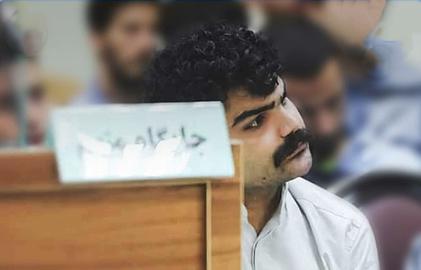Iran is drying up. The Zeyandeh River, which once flowed under five bridges in the showpiece city of Isfahan, now barely exists . In Iran’s northwest, Lake Urmia is the site of an ecological catastrophe. Other bodies of water are in similar danger. Lake Hamoun in Sistan Province and Lake Parishan in Fars Province are going dry, and even the Karoun River, the longest in Iran, is drying up. Last year was a bad year for Iran, as villagers from remote regions had to queue for water in the summer, and the government called on Iranians to reduce their water use.
While much of the Middle East faces a drier climate due to climate change, Nasser Karami, an Iranian climatologist at the University of Bergen in Norway. Karami, who studied hydroclimatology at Shahid Beheshti University in Tehran and received his doctorate in sustainable development from Tehran University, says long-term mismanagement of resources is Iran’s real problem. He spoke to IranWire about the severity of the situation, and the dark future Iran could face if it doesn’t confront the crisis
How has drought affected Iran historically?
Iran is in a dry region. The Greek historian Xenophon wrote about 2500 years ago that the king of Athens said Iranians were a strong people because they had to live in the desert, and so you shouldn’t fight with them. That shows that we have had this experience throughout our history.
Drought, as a climactic phenomenon, is periodic, and has gone on for short periods of time throughout our history. Climatologists estimate that every 11 years, we have had a small drought; every 33 years we have had a slightly more severe drought. About every 100 years, we have had a very severe, intense drought. These were usual droughts.
How is climate change affecting water supplies in Iran?
Because of climate change, all the countries of the Middle East and North Africa have experienced about 20 to 40 percent less rainfall over the past 10 years. They have also experienced about a one degree centigrade rise in temperature. Iran now experiences less than normal rainfall once every two years.
But the average effect of climate change and drought in Iran is less than 20 per cent of the problem. More important is that our water consumption is about two times our ecological capacity. The standard for consumption of all of Iran’s water resources — both groundwater and precipitation — should be about 40 percent. Sixty percent should remain in nature, for the animals, for the plants, for the jungles. But in Iran we use more than 80 percent of all precipitation. Because of that, we could have a water crisis even without drought and climate change. Drought and climate change just push us closer to crisis.
How does drought affect Iran’s security?
There is a serious relationship between violence and unsustainability and lack of water resources. There is a serious idea that the Arab Spring arose because of climate change, because of farmers and villagers who lost their livelihoods because of drought. Even Islamic State may be the child of drought, because farmers and villagers are unemployed, and that’s a common problem in all of the Middle East.
The most violent countries in the world, such as Syria, Iraq, Afghanistan, Pakistan, Sudan, Somalia, are also the countries with the biggest water shortages. There is a strong overlap. That shows us that any country with serious water shortages goes toward unsustainability in economy and social conditions, and goes towards violence, extremism and fundamentalism. Iran’s water shortage means that Iran is going toward these things too.
What are the causes of this crisis?
Throughout our modern history, we spread farming and cultivation across Iran and dug about one million wells and built dams, without any technical assessment or adaptation to geographical conditions. The effects of this mismanagement are greater than the effects of natural causes.
What are the government’s main responsibilities where water management is concerned?
That is the main problem in Iran. The status of the environment is very low, and not just with the government, but with Iranian academics and the Iranian people. The protection of the environment is not high among the demands of political groups within the government or even opposition groups. Because of that, the government does not pay any attention to the environmental problems of Iran.
What should the government do?
The government should stop the use of deep wells, because they rely on groundwater that we should reserve for the future. But the people who use these deep wells are villagers, and the villagers are close to the government. They participate in elections, and they answer to the government in a lot of ways. If the government wants to stop using these wells, they will lose their traditional sponsors.
In recent years, has Iran taken any steps to increase its water efficiency?
No. It’s a very expensive. It would be a very expensive project, for example, to increase the efficiency of irrigation in Iran. But the government doesn’t have the money. Because of the crash of oil prices, it’s not likely to have the money in the near future.
How have western sanctions affected this issue?
Sanctions are important, but this problem is not directly related to the sanctions. Before the sanctions, attention to this issue was about the same as it is now. I haven’t seen any project that was stopped because of sanctions.
How openly are these issues discussed in Iranian media?
The role of the media is very important, and their attention to these problems is not bad. Some TV programs and newspapers have increased their coverage a little in the last year, such as BBC Persian, or Shargh News. Still, their approach is not as serious as it could be, because Iranian journalists have very political minds. Even for subjects like football or cinema they try to find a political solution. The Iranian people don’t express serious demands about the environment, so the media don’t pay very serious attention.
Have cross-border water issues caused Iran to cooperate or enter disputes with its neighbors?
In recent years, we have had serious problems with our neighbors, especially Iraq and Afghanistan, over water resources. Some rivers go from Iran to Iraq, or from Afghanistan to Iran. Because of dam-building in Afghanistan, for example, we lost Lake Hamoun, and now we have a lot of problems in Sistan-Baluchistan province. To rescue Lake Urmia, we would have to change the direction of, for example, the river Zab to Urmia. But that river goes to Iraq, and the people of Iraq need that river.
When you look at Iran’s water problems, what is the worst-case scenario?
I am unhappy. I think at least two thirds of Iran—all of the south of Iran, and some parts of the east of Iran will turn into a landscape like the horn of Africa because of long-term drought. That means that Iran will go toward extremism, fundamentalism, and violence, and that is very dangerous for Iran, and for their neighbors, and for the western countries.
To rescue Iran from that future, we must stop using groundwater. But the government won’t do that, because at least one million people would lose their jobs, and the government can’t make new jobs for them. So the government will continue this very bad behavior with nature and water resources and we will become like Somalia.
visit the accountability section
In this section of Iran Wire, you can contact the officials and launch your campaign for various problems






























comments